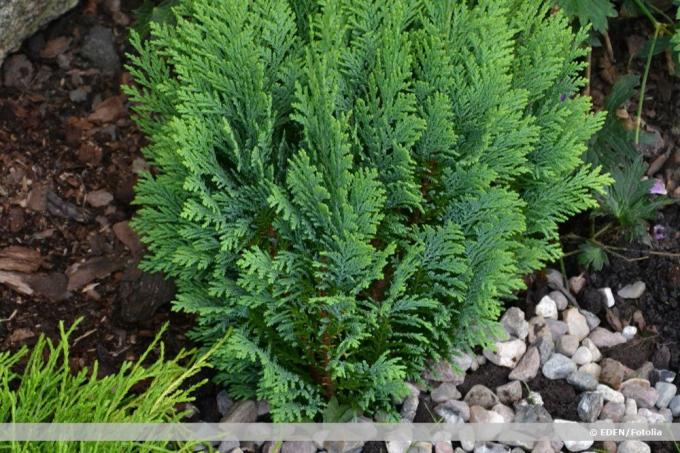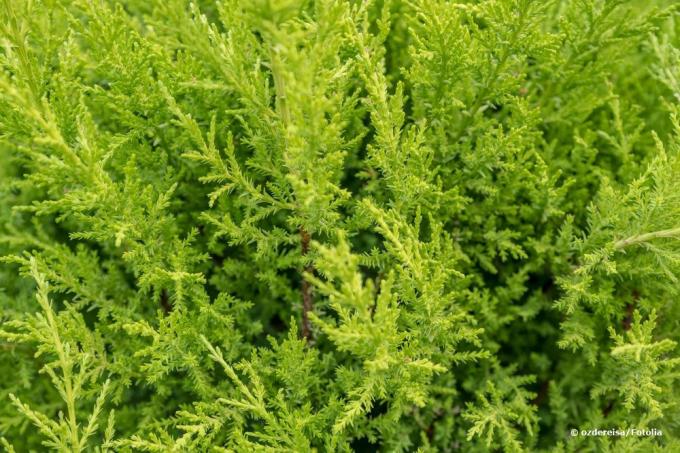
table of contents
- Cypress or false cypress?
- Toxicity
- risk groups
- Children and pregnant women
- animals
- Symptoms
- First aid
- Prevent cypress poisoning
Cypresses can be found in almost every garden, either as a solitary plant, in a bucket or as a dense hedge. They are very versatile. These are evergreen conifers. The market offers numerous cultivated forms, which differ in their growth form and color. However, a planting should always be well thought out, because cypresses as beautiful as they look can be harmful to health.
Cypress or false cypress?
Visually, there is hardly any difference between the two. The real cypress (Cupressus) has its origin in the Mediterranean area and false cypresses (Chamaeocyparis) come mainly from the north-west of America, north-west Africa and East Asia. There are also numerous cultivated forms, the hybrid cypresses (Cupressocyparis). However, all types are:
- evergreen
- conditionally hardy
- extremely robust with fast and dense growth
- easy to care for and durable
Typical characteristics distinguish the cypress trees from other evergreen conifers such as, for example
- the growth form from narrow or broadly conical to narrow columnar, pyramidal, tightly upright, tightly closed, single-stemmed, well-branched and slightly overhanging tips
- scaly, small, pinnate foliage
- needle-shaped, dense foliage is cross-opposite from the branch
- different colors from green to yellow to blue
- ovoid cones, size dependent on species
- Cones only open after years in great heat
- trunk that is heavily lignified in old age
Compared to the real cypress, the false cypress has slightly flattened branches, smaller cones and the seeds ripen earlier.

tip: Grated needles of the false cypress give off a light lemon scent.
Toxicity
In both the real cypress and false cypress, all parts of the plant are poisonous, but mainly
- the leaf tips
- the wood
- the cypress juice and
- the fruiting bodies
The essential oils it contains can cause skin irritation and even symptoms of poisoning. Sometimes a simple touch of the skin is enough. In contrast, the consumption of leaf tips and shoots, as well as the juice of the cypress, can lead to severe poisoning.
The main toxic components in the cypress are
- Thujene
- Pinene
- Terpenes
- Camphene
- Cedrol
- Furfural
- Semperviral
- Sylvestren
- Flavonoids and
- various tannins
tip: Despite its toxicity, cypress oil (oleum cupressi) is still produced from the fruits and young leaves by distillation. This is often used in homeopathy as a remedy for gout, rheumatism, gastric catarrh, eye and ear infections in small doses. It has a disinfecting and vasoconstricting effect.
risk groups
Children and pregnant women
The essential oils present in the cypress are generally more or less harmful to health. However, they can cause more damage to children than to adults. The child's organism is not yet fully developed and is therefore far more vulnerable. If there are cypress trees in the garden or if they are kept in pots on the balcony or terrace, it is advisable to always keep a close eye on the children. Of course, depending on their age, they should also be informed about the toxicity of the conifers.
In addition, pregnant women should also keep a distance from these plants and thus avoid contact. Cypress trees are not only poisonous for the expectant mother, but the poison can also harm the unborn child. It can even lead to miscarriages.

animals
The ingredients of cypresses and false cypresses are not only dangerous for humans, but also also for dogs, cats, rodents (guinea pigs, hamsters) and also for grazing animals such as horses.
Due to the strong play and hunting instinct of dogs and the curiosity of cats, it can quickly happen that these animals come into contact with parts of plants. By ingesting leaves, for example, and then chewing them, the saliva can easily absorb the essential oils, which can lead to symptoms of poisoning
- Gastrointestinal complaints
- cramps
- Changes in the liver and kidneys
- increased urine volume with simultaneous low excretion
- to the point of death.
come.
Horses can also be in a life-threatening danger if they eat more leaves, they like the smell. Disturbances in consciousness can occur. In addition, there is then also an increased risk of infection.
Caution is also advised when pruning cypress trees if there is a garden pond with fish nearby. If clippings fall into the pond, fish can also experience health problems. Depending on the concentration of essential oils, these can even lead to death.
tip: In the presence of small children and pets, the planting of cypresses should be avoided if possible.
Symptoms
First signs of poisoning
Normally, care should always be taken to ensure that there is no poisoning by parts of the cypress plant, regardless of whether it is touched or consumed. However, should it ever happen, action must be taken as quickly as possible. To do this, it is also necessary to identify symptoms of intoxication. The first signs can be
- Strong irritation of the skin through contact with blistering
- severe dark red, painful itchy rashes
- Appearance of pronounced tissue damage
- severe irritation of the mucous membranes after ingestion
- nausea
- severe vomiting (greenish, possibly bloody, typical odor of essential oils)
- Seizures
- Gastrointestinal complaints
- diarrhea
- Flatulence
- Kidney damage with secretion of bloody urine possible
- Irritation of the lower urinary tract
- Symptoms of paralysis, possibly occurring respiratory paralysis
- Miscarriage in pregnant women
- severe poisoning possible death
tip: Cypress trees can also release the toxins into the air. This fact must be taken into account when planting. Sensitive people can already be harmed in terms of health.

First aid
If there is poisoning by parts of the cypress plant, it is imperative that action is taken to prevent worse consequences. Small children in particular can put these in their mouths and swallow them quickly. If it is not clear whether it is really a question of cypress poisoning, the Poison Control Center to be called. All further measures can then be clarified here. The following information must be provided:
- Description of the exact symptoms
- Guesswork about the cause
- what amount was absorbed
- how long ago the recording was made
- who is affected (age, body weight)
At the same time, it is also necessary either to see a doctor or to call the emergency doctor. Until then, the following should be observed:
- always keep calm
- Follow recommendations from the poison control center
- Ensure appropriate parts of the plant
- also vomit
- Avoid hasty or dangerous remedial measures
- First aid only in emergencies, if the doctor is not on site quickly enough
- Inform doctor about all measures and information of the poison control center
In most cases, those affected vomit on their own after ingesting poisonous parts of the plant. If this is not the case, something can be helped, always in consultation with the doctor or poison control center:
- Put your fingers deep in your mouth and press firmly on the base of the tongue
- Give 1 to 2 glasses of lukewarm raspberry juice or lukewarm water
- Stable lateral position when the victim is unconscious, watch breathing, be careful with vomit - risk of suffocation
- If conscious - place the child in the prone position over the thigh
- The head has to hang down a bit so that vomit does not get into the windpipe
- never salt water give (especially dangerous for small children)
- never milk administer (accelerates the absorption of toxins from the intestine)
- Activated carbon can be given in consultation with a poison control center or doctor (1g medicinal charcoal per kg body weight)

tip: Activated charcoal binds toxins in the digestive tract, preventing them from being absorbed by the body. Can also be used for poisoning dogs. Therefore, activated charcoal should not be missing in any emergency pharmacy.
Prevent cypress poisoning
However, poisoning does not always have to occur immediately. To do this, a few measures should be observed:
- Always wash hands when handling cypress trees
- Do not touch your face, mouth or eyes with your hands
- Always wear gloves, long-sleeved clothing and, if necessary, eye protection (absorption of the poison through the skin is possible)
- Do not leave the pruning lying around, dispose of it immediately
- Keep an eye on children and pets
- Maintain sufficient distance to the neighboring property
- also keep a large distance from the fence if a pasture area is adjacent
- maybe avoid planting cypress trees in general
tip: Alternatively, hornbeam, common beech or bamboo can also be used for a hedge.
Note: Please note that this article does not in any way replace a visit to the doctor. There is no guarantee that medical statements are correct.
You will find detailed information on first aid in the event of poisoning and important information on poison control centers here.
